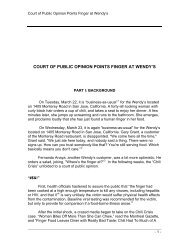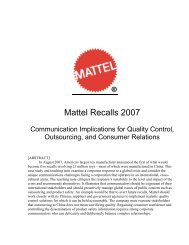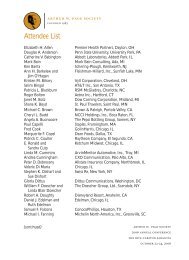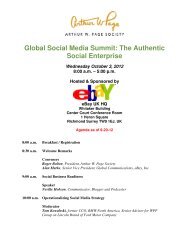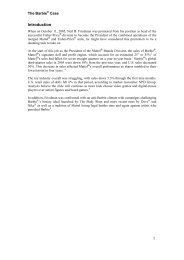The Barbie Case - The Arthur Page Society
The Barbie Case - The Arthur Page Society
The Barbie Case - The Arthur Page Society
Create successful ePaper yourself
Turn your PDF publications into a flip-book with our unique Google optimized e-Paper software.
<strong>The</strong> Lasser Years<br />
Prior to Lasser’s stewardship which began in 1985, Putnam<br />
was regarded as stodgy and conservative in its approach to<br />
money management. Under Lasser, however, the firm<br />
experienced tremendous growth. Between 1993 and 1999<br />
alone, assets under management grew 33% compounded<br />
annually from $90 billion to $391 billion, outpacing the S&P<br />
500 which grew 26% compounded over the same time<br />
period. “Truth in labeling,” the firm’s rallying cry, affirmed a<br />
commitment to style specific products (i.e., growth funds<br />
only investing in growth stocks, small cap funds in small<br />
stocks etc.) that resonated strongly with investors<br />
and investment advisors. In the late 1990’s, the<br />
firm also rode the Internet bubble, betting<br />
heavily on technology and telecommunications<br />
stocks in many of its funds. Portfolio managers<br />
of popular growth funds like OTC Emerging<br />
Growth became Wall St. celebrities because of<br />
their spectacular performance (+127% in 1999)<br />
and received gaudy compensation packages.<br />
Lasser himself was routinely one of the best paid<br />
executives in the industry, taking home over $100 million<br />
between 1998 and 2003. Critics viewed the compensation of<br />
Lasser and others as emblematic of a much broader problem<br />
– a developing culture of corporate greed that came at the<br />
expense of individual investors. According to a December<br />
2003 article in Money magazine:<br />
“<strong>The</strong> firm embraced one of Wall Street’s oldest and<br />
most cynical sayings: ‘When the ducks quack, feed ‘em.’<br />
Putnam began selling any fund that gave – or appeared<br />
to give – investors what they wanted, regardless of<br />
whether it was a prudent, intelligent or safe way to<br />
invest. <strong>The</strong> firm pandered to the worst instincts of<br />
investors – and to the brokers who are supposed to<br />
help those investors.” 4<br />
Post-Technology Boom Problems<br />
When the technology bubble burst in 2000, Putnam fell hard.<br />
Assets under management were cut by 36%, far worse than<br />
the 14% decline in the S&P during that time period. <strong>The</strong><br />
move from $391 billion at the end of 1999 to $250 billion at<br />
the end of 2002 prompted the firing of the very portfolio<br />
managers whose bets on technology fueled the firm’s growth<br />
just two years prior. Even Lasser’s compensation package<br />
was slashed –declining from $30 million in 2001 to $10<br />
million in 2002. 5 While Putnam remained the nation’s fifth<br />
largest mutual fund manager, the company’s revered run had<br />
come to an end. <strong>The</strong> more the negative consequences of<br />
arthur w. page society<br />
such aggressive growth tactics became evident, the more<br />
Putnam’s credibility within the investment community was<br />
called into question.<br />
Ed Haldeman, formerly CEO of Delaware Investments, was<br />
hired as co-Chief Investment Officer in 2002 to right the ship.<br />
He was charged with the responsibility of overhauling the<br />
investment division, getting performance back on track and<br />
restoring Putnam’s image as a prudent, trust-worthy<br />
investment manager. Both inside and outside the company, it<br />
was commonly assumed that Haldeman would eventually<br />
succeed Lasser as the CEO of Putnam.<br />
Company Position Dates<br />
Putnam Investments Chief Executive Officer 2003–present<br />
Putnam Investments Chief Investment Officer 2002–2003<br />
Delaware Investments Chief Executive Officer 2000–2002<br />
United Asset Management President & Chief Operating Officer 1998–2000<br />
Cooke & Bieler Inc. Partner and Director 1974–1998<br />
Market Timing in Mutual Funds<br />
Mutual Fund Pricing<br />
<strong>The</strong> price of a mutual fund measures the value of the assets<br />
(stocks or bonds) that it owns. Unlike stocks, whose prices<br />
are continuously updated, a mutual fund’s price is updated<br />
once per day, at 4pm in New York, to capture the day’s<br />
movements up or down of the securities owned in that fund.<br />
Because many international markets close well ahead of 4pm<br />
EST, the value the international securities are assigned in that<br />
fund will not reflect the latest US market activity. Insofar as<br />
the prices of international stocks are affected by movements<br />
in the US stock market, investors can profit from this “stale<br />
pricing” in mutual funds holding a significant number of<br />
international securities.<br />
International Fund A owns exclusively shares of<br />
Japanese electronics companies whose performance can<br />
be largely predicted by sales of Intel microprocessors.<br />
On Tuesday at 9am EST, Intel reports that its 4th<br />
Quarter sales were well above expectations. Based on<br />
these results, market timers buy International Fund A<br />
because they expect the Japanese stocks it owns will<br />
react favorably when the Tokyo market opens on<br />
Wednesday. This favorable reaction, however, will not<br />
be captured in the price of International Fund A on<br />
Tuesday, but will be captured when the US market<br />
closes on Wednesday.<br />
17



